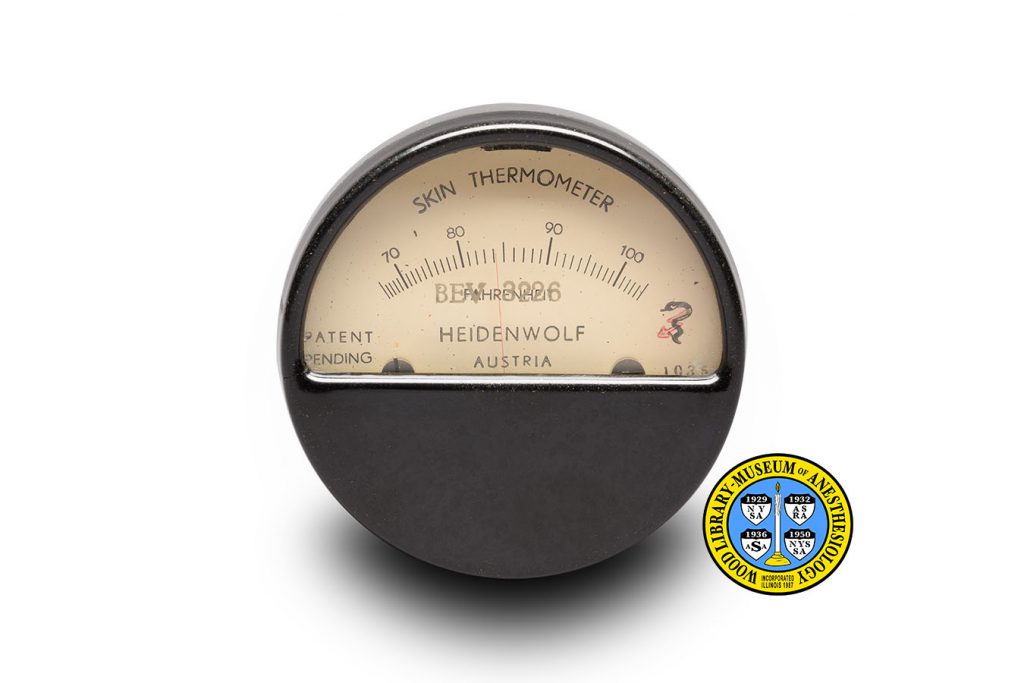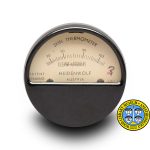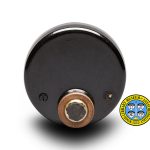Heidenwolf Thermometer
Temperature is one of several patient vital signs that anesthesiologists monitor during surgery. Thermometers that register the temperature of the skin have been used from the 1860s to the present day. Austrian inventor Hermann Heidenwolf obtained several U. S. patents from the 1940s through the 1970s. He was granted the patent for this thermomagnetic skin thermometer in 1947. The device uses the interaction of temperature-sensitive alloys with a magnet to register temperature at the point of contact with the skin. Although it was recommended for clinical use, the Heidenwolf thermometer was better-known for its use in forensic medicine.
Catalog Record: Heidenwolf Thermometer Heidenwolf Thermometer
Access Key: aqkr
Accession No.: 2007-06-26-1
Title: Heidenwolf skin thermometer / [Lapp Finze Eisenwarenfabriken AG].
Author: Heidenwolf, Hermann.
Title variation: Alt Title
Title: Heidenwolf magnetic thermometer.
Title variation: Alt Title
Title: Heidenwolf thermomagnetic thermometer.
Publisher: Austria : Lapp Finze Eisenwarenfabriken AG, [between 1947 and 1980].
Physical Description: 1 thermometer : plastics, silver and other metals, cardboard?, textile? ; 4 x 7 diameter cm.
Subject: Monitoring, Intraoperative – instrumentation.
Subject: Temperature Measurement.
Subject: Thermometers.
Note Type: General
Notes: The first year in the date range is based on the U. S. patent date. The second year in the date range is based on the date that the original manufacturer was acquired; the actual date of manufacture likely to have been somewhat earlier.
Described from the user’s perspective, with the gauge facing upward.
Note Type: With
Notes: Unmarked, two-piece case, 5 x 8 centimeters diameter. Made of cardboard covered with brown leatherette. The interior of the lid is lined with cloth.
Note Type: Citation
Notes: Dornette WHL. The use of temperature monitoring devices in anesthesia. Current Researches in Anesthesia and Analgesia. November-December, 1956;35(6):584-599.
Note Type: Citation
Notes: Dornette WL. Thermometry in clinical practice. International Anesthesiology Clinics. May, 1965;3(3):473-488.
Note Type: Citation
Notes: Dornette WHL, Brechner VL. Instrumentation in Anesthesiology. Philadelphia: Lea & Febiger, 1959.
Note Type: Citation
Notes: Foregger Company. Catalog 16. Roslyn Heights, Long Island, New York; Foregger Company, 1960:85.
Note Type: Citation
Notes: Heidenwolf H. Apparatus for measuring temperature. Lapp Finze Ag, assignee. US Patent 2,642,742. September 5, 1953.
Note Type: Citation
Notes: Kaliszan M, Hauser R, Jankowski Z. Time of death estimation based on observation of post-mortem changes, especially decrease in body temperature. Problems of Forensic Sciences. 2005;65:358-372.
Note Type: Citation
Notes: Roto Frank AG website. http://ftt.roto-frank.com/en/company/about-roto/chronicle/. Accessed July 31, 2017.
Note Type: Citation
Notes: Seguin, E. C. The use of the thermometer in clinical medicine as a means of diagnosis and prognosis. Chicago Medical Journal. May, 1866;23(5):193-201.
Note Type: Physical Description
Notes: One thermometer; Squat black plastic cylinder with an extruded knob on the back; This knob holds a slightly convex silver disc; The upper half of the front side is made of transparent plastic; Below this window is a needle gauge, possibly made of cardboard; The gauge is marked: “SKIN THERMOMETER [new line] [graduation marks] 70, 80, 90, 100 [new line] FAHRENHEIT [logo of a snake printed in black superimposed over a jagged arrow printed in red, both facing left] [new line] HEIDENWOLF [new line] AUSTRIA [new line] PATENT PENDING [new line] 1035”; The transparent plastic is marked “BEV 3226”.
Note Type: Reproduction
Notes: Photographed by Mr. Steve Donisch, June 19, 2017.
Note Type: Acquisition
Notes: Purchase.
Note Type: Historical
Notes: Anesthetics may lower the body’s temperature. Temperature is one of several patient vital signs that anesthesiologists monitor during surgery. Thermometers that register the temperature of the skin have been used from the 1860s to the present day.
Austrian inventor Hermann Heidenwolf obtained several U. S. patents from the 1940s through the 1970s. He applied to patent his skin thermometer in 1947; the patent was granted in 1953. He assigned this patent to the Austrian hardware company, Lapp Finze Eisenwarenfabriken AG. Lapp Finze was acquired by the German hardware company, Roto Frank AG, in 1979. The device was offered in the 1960 catalog of the Foregger Company, a New York anesthesia equipment maker. It did not appear in any other Foregger catalog.
The cataloged object is a thermomagnetic thermometer. This uses the interaction of temperature-sensitive alloys with a magnet to register temperature at the point of contact with the skin. A silver disc on the back of the instrument is an extension of one component in the interior. It is that is pressed against the skin, causing the needle gauge to move.
In 1953, Heidenwolf and Schwarz published their work on the measurement of body temperature as a method of determining the time of a person’s death. From the 1950s to the present, that paper has been frequently cited in the literature of medical jurisprudence and forensics.
Note Type: Publication
Notes: Schwarz F, Heidenwolf H. Post-mortem cooling and its relation to the time of death. International Criminal Police Review. December, 1953;73:339-344.
Note Type: Exhibition
Notes: Selected for the WLM website.



